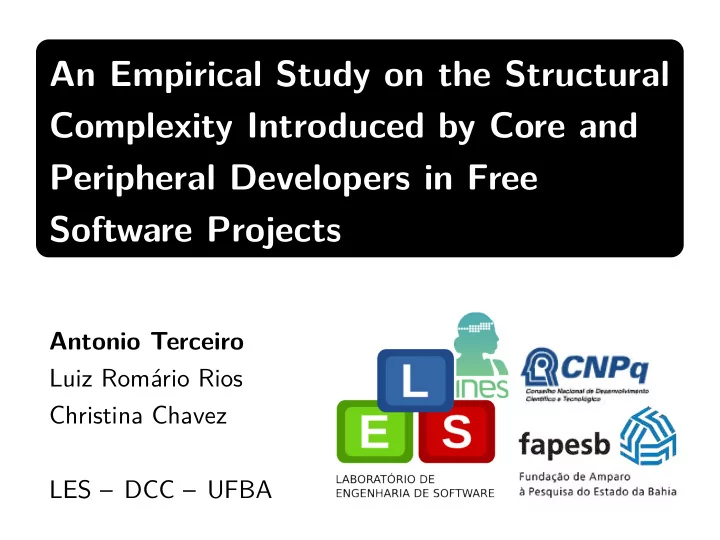

An Empirical Study on the Structural Complexity Introduced by Core and Peripheral Developers in Free Software Projects Antonio Terceiro Luiz Romário Rios Christina Chavez LES – DCC – UFBA
Motivation
Developers rewriting entire systems ● EOG (GNOME's image viewer) ● GNOME-session
Why rewriting? The code became so complex that rewriting pays off.
Where does all that complexity come from? ● Conventional setting: appointed designers ● Free software projects: evolutionary designs
Software Aging – Parnas (1994) ● Lack of movement ● Ignorant surgery
In this paper we investigate ● Developers' level of participation ● Structural complexity
Background
Free software projects ● Source code availability ● User/developer symbiosis ● Non-contractual work ● Work is self-assigned ● Geographical distribution
Core and periphery in free software projects Passive users Initiator Active users Core developers Co-developers Release Coordinator The “onion” model. Adapted from [Crowston and Howison, 2005]
Structural complexity ● Architectural concern ● Coupling and Cohesion [Darcy et al, 2005]
SC definition [Chidamber and Kemerer, 1994] (CBO) [Hitz and Montazeri, 1995] (LCOM4)
Structural complexity Maintenance effort [Darcy et al, 2008]
Structural complexity Maintenance effort Number of bugs [Midha, 2008]
Structural complexity Contributions from new developers [Midha, 2008]
Structural complexity Attractiveness [Meirelles et al, 2010] (Brazilian Software Engineering Conf.) Collaboration with CCSL - IME/USP (Paulo Meirelles, João Miranda, Carlos Santos Jr., Fabio Kon)
Research Hypotheses
H 1 changes made by core developers introduce less structural complexity than those made by periphery developers.
H 2 among the changes that reduce structural complexity, the ones made by core developers achieve greater structural complexity reduction than those made by periphery developers
Research Design
In this study we analyse changes made to the source code of free software projects for the purpose of characterization with respect to structural complexity added or removed and level of developer participation, from the perspective of the researcher in the context of the web server application domain.
Research method Observational study
Unit of analysis Software change (“commit”, “checkin”)
Independent variable ● L : the level of participation ● Core ● Periphery
Dependent variables ● SC : structural complexity ● ∆SC : SC variation in the change ● |∆SC| : absolute variation
Sample ● Available in Debian GNU/Linux ● Written in C ● Publicly accessible version control repository ● Web server application domain
Data collection ● Version control repository mining ● Determine list of relevant changes (those that actually change source code) ● Extract source metrics and change metadata (author, changed files, date etc) ● Load the data in a relational database for further calculations
Projects analyzed
Data Analysis and Results
Full dataset ● Available on-line ● 13553 changes ● 9944 by core (73.36%) Core ● 3609 by periph. Periph. (26.63%)
Dataset for testing H 1 ● Removed: ∆SC = 0 ● 2513 changes ● 1994 by core (79.35%) ● 519 by periph. (20.65%) Core Periph.
Test for H 1 ● Performed a t-test ● Supported by the dataset (p < 0.05) ● Changes made by core developers introduce less structural complexity than changes made by peripheral developers.
Dataset for testing H 2 ● Kept: ∆SC < 0 ● 1165 changes ● 939 by core (80.60%) ● 226 by periph. Core (19.40%) Periph.
Test for H 2 ● Performed a t-test. ● Supported by the dataset (p < 0.05) ● among the changes that reduce structural complexity, the ones made by core developers achieve greater structural complexity reduction than those made by periphery developers.
Threats to Validity
On the suitability of the t-test for non-normal distributions ● Sample is “large enough” [Wohlin et al, 2000] ● Wilcoxon/Mann-Whitney test provided similar results
Choice of sample Sample may not be representative of the population (only C projects)
Single independent variable Other factors that may affect the structural complexity were not considered
Committers X authors ● Developer identification may be flawed ● OTOH committer participates in the design decision
Nature of changes not analyzed Type of maintenance may be the actual cause of variation in SC
Conclusions
Difference between core and periphery Core and periphery provide code of different complexity.
Importance of core team Responsible for keeping the project's conceptual integrity [Brooks, 1995]
But projects cannot refuse new developers ● Not all projects can keep the same core team forever ● Project management could help new developers
Future work (1/2) ● Testing different developer characteristics ● Testing projects individually ● Richer characterization of changes
Future work (2/2) ● Extending the dataset (app. domains, languages) ● Analyze developer evolution
Thank you
References (1/2) th international D. L. Parnas, “Software aging,” in ICSE ’94: Proceedings of the 16 conference on Software engineering. Los Alamitos, CA, USA: IEEE Computer Society Press, 1994, pp. 279–287. K. Crowston and J. Howison, “The Social Structure of Free and Open Source Software Development,” First Monday, vol. 10, no. 2, 2005. D. P. Darcy, C. F. Kemerer, S. A. Slaughter, and J. E. Tomayko, “The Structural Complexity of Software: An Experimental Test,” IEEE Transactions on Software Engineering, vol. 31, no. 11, pp. 982–995, Nov. 2005. S. Chidamber and C. Kemerer, “A metrics Suite for Object Oriented Design,” IEEE Trans. Sftware Eng., vol. 20, no. 8, pp. 476–493, 1994. M. Hitz and B. Montazeri, “Measuring coupling and cohesion in object-oriented systems,” in Proceedings of the International. Symposium on Applied Corporate Computing, 1995.
References (2/2) V. Midha, “Does Complexity Matter? The Impact of Change in Structural Complexity on Software Maintenance and New Developers’ Contributions in Open Source Software,” in ICIS 2008 Proceedings, 2008. Paulo Meirelles, Carlos Santos Jr., João Miranda, Fabio Kon, Antonio Terceiro, Christina Chavez. A Study of the Relationships between Source Code Metrics and Attractiveness in Free Software Projects, 2010 (SBES 2010) C. Wohlin, P. Runeson, M. Host, C. Ohlsson, B. Regnell, and A. Wessl ́ n, Experimentation in Software Engineering: an Introduction. Ed. Kluver Academic Publishers, 2000. F. P. Brooks.Jr, The Mythical Man Month: Essays on Software Engineering. Addison- Wesley , April 1995, ch. “Aristocracy, Democracy, and System Design”.
Recommend
More recommend